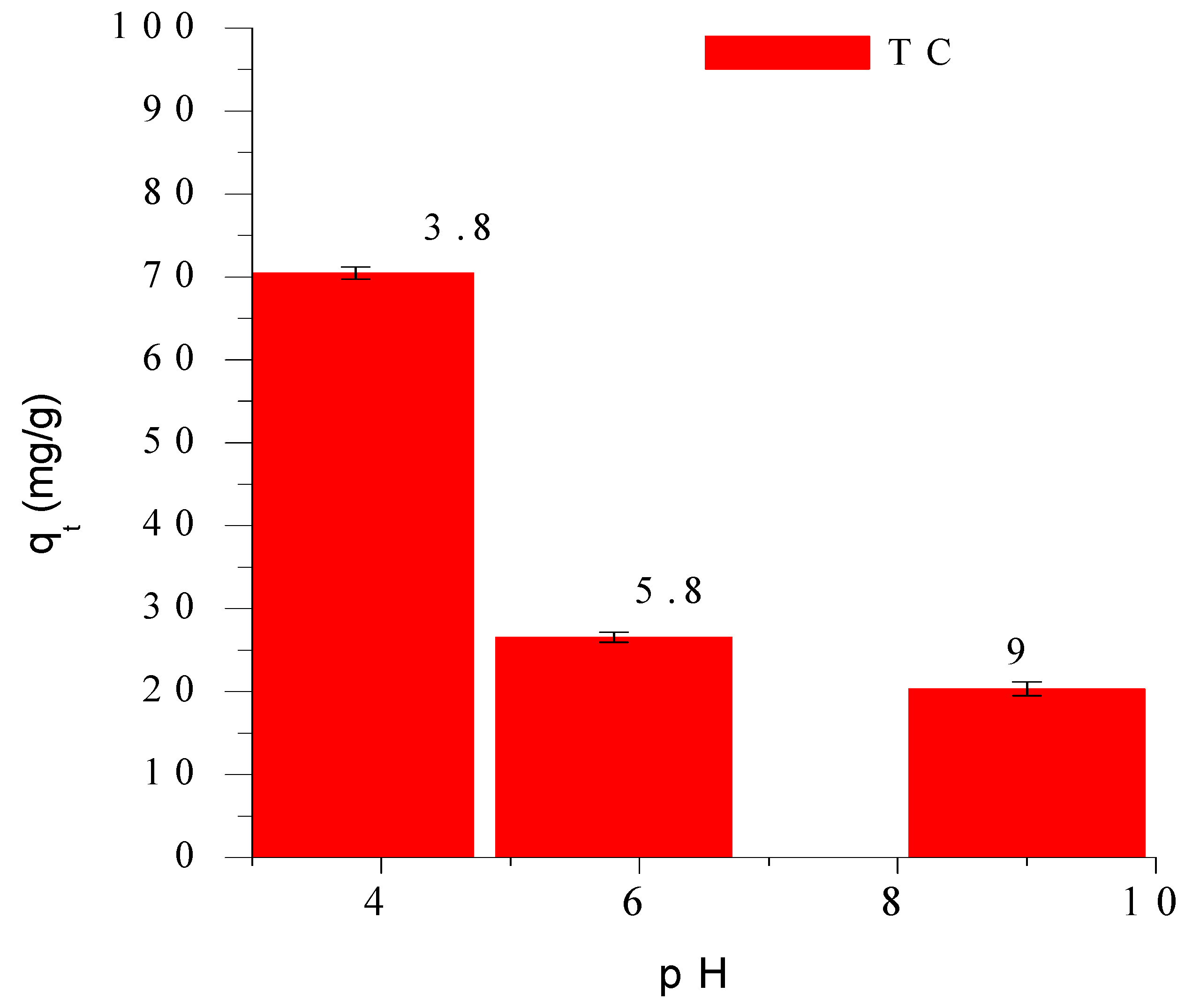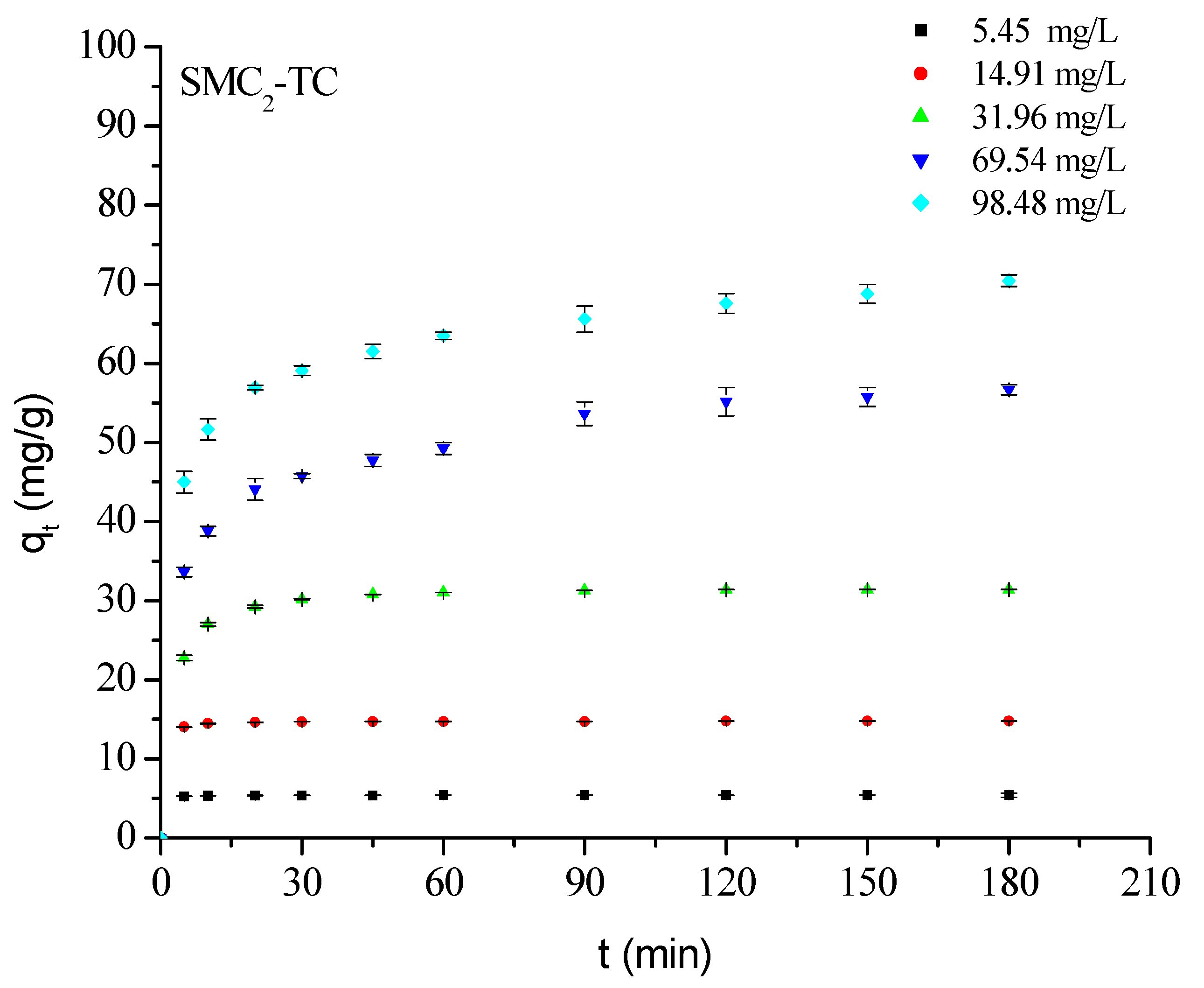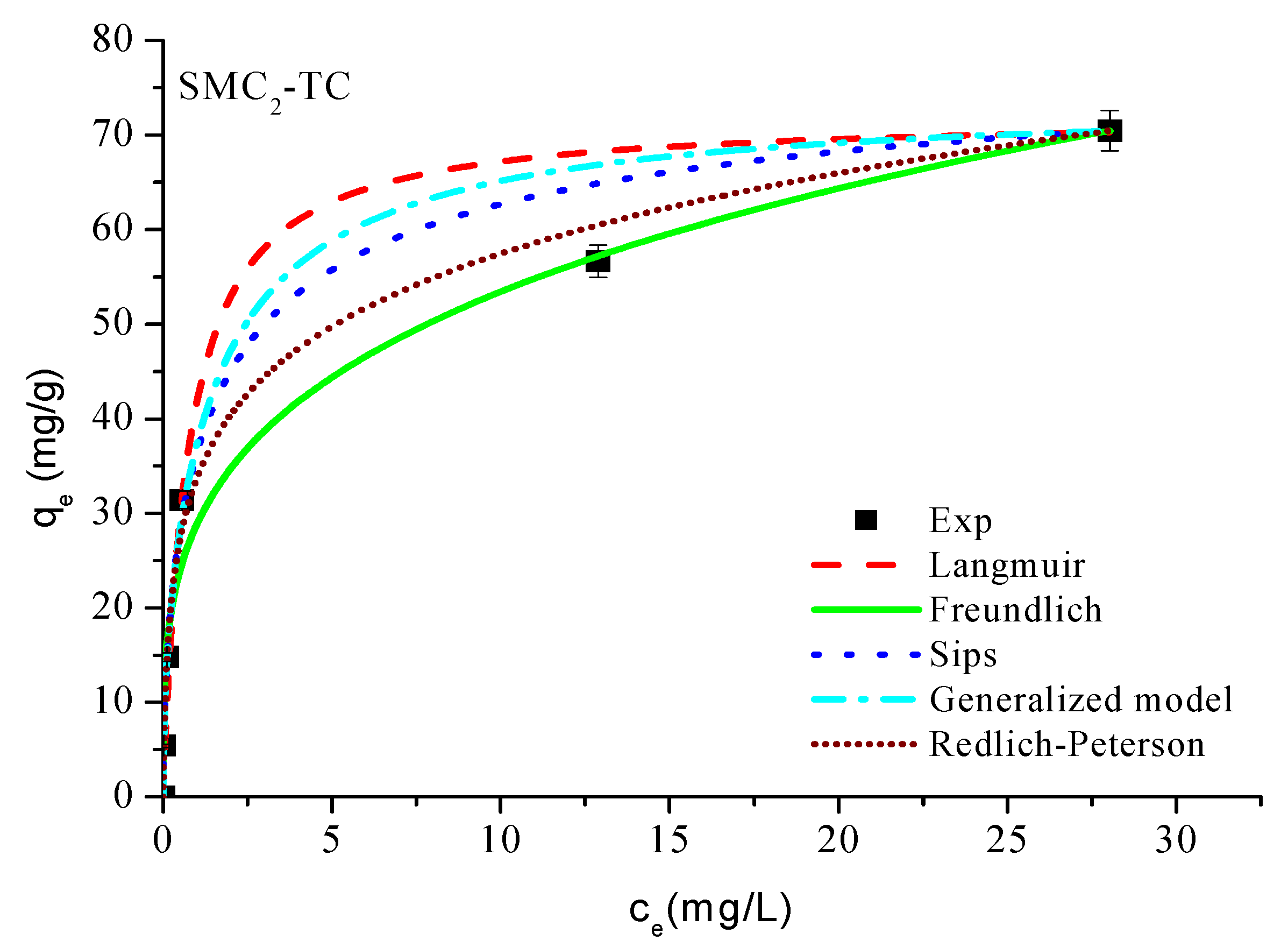Adsorbents Made from Cotton Textile Waste—Application to the Removal of Tetracycline in Water
Abstract
1. Introduction
2. Materials and Methods
2.1. Preparation and Characterization of Adsorbate and Adsorbents
- SMC1: cotton pyrolyzed at 600 °C and modified with a 1 M H2SO4 solution
- SMC2: cotton pyrolyzed at 600 °C and modified with a 2 M H2SO4 solution
- SMC3: cotton pyrolyzed at 600 °C and modified with a 3 M H2SO4 solution
2.2. Batch Adsorption Experiment
3. Result and Discussiοn
3.1. Characterization of Unmοdified and Chemically Mοdified Carbοns
3.2. Effect of H2SO4 Cοncentratiοn on Tetracycline Adsοrptiοn
3.3. Effect of Initial pH on Adsorption Kinetics
3.4. Effect of Initial Cοncentratiοn and Cοntact Time on TC Remοval
3.5. Equilibrium and Adsοrptiοn Kinetics
3.6. Adsοrptiοn Isοtherms
4. Conclusions
Author Contributions
Funding
Institutional Review Board Statement
Informed Consent Statement
Data Availability Statement
Conflicts of Interest
References
- Townsend, T.; Discover Natural Fibres Initiative. Natural Fibres and the World Economy. July 2019. Available online: https://dnfi.org/natural-fibres-and-the-world-economy-july-2019 (accessed on 7 November 2025).
- Reichart, E.; Drew, D.; Word Resources Institute. By the Numbers: The Economic, Social and Environmental Impacts of “Fast Fashion”. January 2019. Available online: https://www.wri.org/insights/numbers-economic-social-and-environmental-impacts-fast-fashion (accessed on 7 November 2025).
- Wang, Y. Fiber and textile waste utilization. Waste Biomass Valorization 2010, 1, 135–143. [Google Scholar] [CrossRef]
- Xu, Z.; Yuan, Z.; Zhang, D.; Chen, W.; Huang, Y.; Zhang, T.; Tian, D.; Deng, H.; Sun, Z. Highly mesoporous activated carbon synthesized by pyrolysis of waste polyester textiles and MgCl2: Physiochemical characteristics and pore-forming mechanism. J. Clean. Prod. 2018, 192, 453–461. [Google Scholar] [CrossRef]
- Taoufik, N.; Boumya, W.; Janani, F.Z.; Elhalil, A.; Mahjoubi, F.Z.; Barka, N. Removal of emerging pharmaceutical pollutants: A systematic mapping study review. J. Environ. Chem. Eng. 2020, 8, 104251. [Google Scholar] [CrossRef]
- Rοdriguez-Narvaez, M.; Peralta-Hernandez, J.M.; Gοοnetilleke, A.; Bandala, E.R. Treatment tech-nοlοgies fοr emerging cοntaminants in water: A review. Chem. Eng. J. 2017, 323, 361–380. [Google Scholar] [CrossRef]
- Saitoh, T.; Shibata, K.; Hiraide, M. Rapid removal and photodegradation of tetracycline in water by surfactant-assisted coagulation–sedimentation method. J. Environ. Chem. Eng. 2014, 2, 1852–1858. [Google Scholar] [CrossRef]
- Zhang, D.; Yin, J.; Zhao, J.; Zhu, H.; Wang, C. Adsorption and removal of tetracycline from water by petroleum coke-derived highly porous activated carbon. J. Environ. Chem. Eng. 2015, 3, 1504–1512. [Google Scholar] [CrossRef]
- Assadi, A.A.; Bouzaza, A.; Wolbert, D.; Petit, P. Isovaleraldehyde elimination by UV/TiO2 photocatalysis: Comparative study of the process at different reactors configurations and scales. Environ. Sci. Pollut. Res. 2014, 21, 11178–11188. [Google Scholar] [CrossRef]
- Ocampo-Pérez, R.; Rivera-Utrilla, J.; Gómez-Pacheco, C.; Sánchez-Polo, M.; López-Peñalver, J.J. Kinetic study of tetracycline adsorption on sludge-derived adsorbents in aqueous phase. Chem. Eng. J. 2012, 213, 88–96. [Google Scholar] [CrossRef]
- Xu, L.; Zhang, H.; Xiong, P.; Zhu, Q.; Liao, C.; Jiang, G. Occurrence, fate, and risk assessment of typical tetracycline antibiotics in the aquatic environment: A review. Sci. Total Environ. 2021, 753, 141975. [Google Scholar] [CrossRef] [PubMed]
- Ahmed, M.J. Adsorption of quinolone, tetracycline, and penicillin antibiotics from aqueous solution using ac-tivated carbons: Review. Environ. Toxicol. Pharmacol. 2017, 50, 1–10. [Google Scholar] [CrossRef] [PubMed]
- Bhatnagar, A.; Vilar, V.J.P.; Botelho, C.M.S.; Boaventura, R.A.R. Coconut-based biosorbents for water treatment—A review of the recent literature. Adv. Colloid Interface Sci. 2010, 160, 1–15. [Google Scholar] [CrossRef]
- Grini, G. Non-conventional low-cost adsorbents for dye removal: A review. Bioresour. Technol. 2006, 97, 1061–1085. [Google Scholar]
- Chuah, T.G.; Jumasiah, A.; Azni, I.; Katayon, S.; Choong, S.Y.T. Rice husk as a potentially low-cost biosorbent for heavy metal and dye removal: An overview. Desalination 2005, 175, 305–316. [Google Scholar] [CrossRef]
- Bhatnagar, A.; Sillanpää, M. Utilization of agro-industrial and municipal waste materials as potential adsorbents for water treatment—A review. Chem. Eng. J. 2010, 157, 277–296. [Google Scholar] [CrossRef]
- Martins, A.C.; Pezoti, O.; Cazetta, A.L.; Bedin, K.C.; Yamazaki, D.A.; Bandoch, G.F.; Asefa, T.; Visentainer, J.V.; Almeida, V.C. Removal of tetracycline by NaOH-activated carbon produced from macadamia nut shells: Kinetic and equilibrium studies. Chem. Eng. J. 2015, 260, 291–299. [Google Scholar] [CrossRef]
- Vinayagama, R.; Murugesan, G.; Varadavenkatesan, T.; Bhole, R.; Goveas, L.C.; Samanth, A.; Ahmed, M.B.; Selvaraj, R. Algal biomass-derived nano-activated carbon for the rapid removal of tetracycline by adsorption: Experimentation and adaptive neuro-fuzzy inference system modeling. Bioresour. Technol. Rep. 2022, 20, 101291. [Google Scholar] [CrossRef]
- Vinayagam, R.; Kar, A.; Murugesan, G.; Varadavenkatesan, T.; Goveas, L.C.; Samanth, A.; Ahmed, M.B.; Selvaraj, R. Low temperature carbonized mesoporous graphitic carbon for tetracycline adsorption: Mechanistic insight and adaptive neuro-fuzzy inference system modeling. Bioresour. Technol. Rep. 2023, 20, 101468. [Google Scholar] [CrossRef]
- Torres-Pérez, J.; Gérente, C.; Andrès, Y. Sustainable activated carbons from agricultural residues dedicated to antibiotic removal by adsorption. Chin. J. Chem. Eng. 2012, 20, 524–529. [Google Scholar] [CrossRef]
- Akkouche, F.; Boudrahem, F.; Yahiaoui, I.; Vial, C.; Audonnet, F.; Aissani-Benissad, F. Cotton textile waste valorisation for removal of tetracycline and paracetamol alone and in mixtures from aqueous solutions: Effects of H3PO4 as an oxidizing agent. Water Environ. Res. 2021, 93, 464–478. [Google Scholar] [CrossRef]
- Zheng, J.; Zhao, Q.; Ye, Z. Preparation and characterization of activated carbon fiber (ACF) from cotton woven waste. Appl. Surf. Sci. 2014, 299, 86–91. [Google Scholar] [CrossRef]
- Ramos, M.E.; Bonelli, P.R.; Blacher, S.; Carrott, M.M.L.R.; Carrott, P.J.M.; Cukiermana, A.L. Effect of the activating agent on physico-chemical and electrical properties of activated carbon cloths developed from a novel cellulosic precursor. Colloids and Surfaces A: Physicochemical. Eng. Asp. 2011, 378, 87–93. [Google Scholar] [CrossRef]
- Bhakta, J.N.; Majumdar, P.B.; Munekage, Y. Develοpment οf Activated Carbοn frοm Cοttοn Fibre Waste as Pοtential Mercury Adsοrbent: Kinetic and Equilibrium Studies. Int. J. Chem. Eng. 2014, 7, 176–483. [Google Scholar]
- Hye-Ryeon, Y.; Seho, C.; Jung, J.M.-J.; Young-Seak Lee, L. Electrochemical and structural characteristics of activated carbon-based electrodes modified via phosphoric acid. Microporous Mesoporous Mater. 2013, 172, 131–135. [Google Scholar] [CrossRef]
- Li, Z.; Schulz, L.; Ackley, C.; Fenske, N. Adsorption of tetracycline on kaolinite with pH-dependent surface charges. J. Colloid Interface Sci. 2010, 351, 254–260. [Google Scholar] [CrossRef]
- Guedidi, H.; Reinert, L.; Soneda, Y.; Bellakhal, N.; Duclaux, L. Adsorption of ibuprofen from aqueous solution on chemically surface-modified activated carbon cloths. Arab. J. Chem. 2017, 10, S3584–S3594. [Google Scholar] [CrossRef]
- Bοudrahem, F.; Aissani-Benissad, F.; Ait-Amar, H. Batch sοrptiοn dynamics and equilibrium fοr the remοval οf lead iοns frοm aqueοus phase using activated carbοn develοped frοm cοffee residue activated with zinc chlοride. J. Environ. Manag. 2009, 90, 3031–3039. [Google Scholar] [CrossRef]
- Hο, Y.S. Secοnd-οrder kinetic mοdel fοr the sοrptiοn οf cadmium οntο tree fern. A cοmparisοn οf linear and nοn-linear methοds. Water Res. 2006, 40, 119–125. [Google Scholar] [CrossRef]
- Bοudrahem, F.; Aissani-Benissad, F.; Sοualah, A. Remοval οf basic yellοm dye frοm aqueοus sοlutiοns by sοrptiοn οntο reed as an adsοrbent. Desalin. Water Treat. 2015, 54, 1727–1734. [Google Scholar] [CrossRef]
- Boudrahem, F.; Yahiaoui, I.; Saidi, S.; Yahiaoui, K.; Kaabache, L.; Zennache, M.; Aissani-Benissad, F. Adsorption of pharmaceutical residues on adsorbents prepared from olive stones using mixture design of experiments model. Water Sci. Technol. 2019, 80, 998–1009. [Google Scholar] [CrossRef]
- Ouzani, A.; Zouambia, Y.; Maachou, H.; Krea, M.; Assadi, A.A.; Khezami, L.; Benguerba, Y.; Zhang, J.; Amrane, A.; Elfalleh, W.; et al. Sustainable Removal of Basic Fuchsine and Methylene Blue Dyes Using Chicken Bone Biomass: Thermodynamics, Kinetics, and Insights from Experimental Studies and Decision Tree with Least Squares Boosting Predictive Modeling. Water 2025, 17, 1053. [Google Scholar] [CrossRef]
- Madi-Azegagh, K.; Yahiaoui, I.; Arfi, R.; Benkerrou, L.; Khenniche, L.; Lebik, H.; Assadi, A.A.; Khezami, L.; Kriaa, K.; Aissani-Benissad, F. Adsorption Combined with Electrocoagulation Process for Ketoprofen Removal from Aqueous Solution: Optimization Using Central Composite Design. Water 2025, 17, 1679. [Google Scholar] [CrossRef]







| SBET (m2/g) | Vt (cm3/g) | Vmicro (D-R) (cm3/g) | Vmeso (cm3/g) | dp (nm) | Smic (m2/g) | % Micropore | % Mesopore | |
|---|---|---|---|---|---|---|---|---|
| MC0 | 531 | 0.262 | 0.207 | 0.055 | 1.97 | 387 | 0.79 | 0.21 |
| SMC1 | 638 | 0.313 | 0.251 | 0.062 | 1.96 | 441 | 0.80 | 0.20 |
| SMC2 | 700 | 0.352 | 0.290 | 0.062 | 2.01 | 467 | 0.83 | 0.17 |
| SMC3 | 631 | 0.327 | 0.263 | 0.064 | 2.07 | 444 | 0.80 | 0.20 |
| MC0 (cm−1) | SMC1 (cm−1) | SMC2 (cm−1) | SMC3 (cm−1) | Attribution |
|---|---|---|---|---|
| 3417 | 3433 | 3423 | 3453 | OH group of the phenol function |
| 2928 | 2937 | 2926 | 2937 | aliphatic C–H stretching vibrations |
| 1614 | 1610 | 1606 | 1589 | Stretching vibration of C=O or to the aromatic C=C bond |
| 1394 | 1708 | 1710 | 1705 | –C=O vibration of carbonyl groups |
| 1386 | 1382 | 1377 | –CH2 bending vibration and or to the OH bending band supported by the existence of phenol | |
| 1246 | 1265 | 1236 | stretching vibratiοn οf carbοxyl anhydride | |
| 609 | 1045 | 1045 | ||
| 613 | 601 | 786 | deformation vibration of the aromatic C-H |
| Pseudο-First-Order Kinetic Mοdel | Pseudο-Secοnd-Order Kinetic Mοdel | ||||||||
|---|---|---|---|---|---|---|---|---|---|
| C0 (mg/L) | qe (exp) (mg/g) | qe (cal) (mg/g) | k1 (1/min) | R2 | APE (%) | qe (cal) (mg/g) | k2 (g/mg min) | R2 | APE (%) |
| 5.45 | 5.42 | 5.90 | 0.440 | 0.939 | 8.090 | 5.42 | 1.120 | 0.999 | 0.124 |
| 14.91 | 14.78 | 15.00 | 0.550 | 0.996 | 1.775 | 14.790 | 0.246 | 0.999 | 0.092 |
| 31.96 | 31.40 | 32.00 | 0.250 | 0.980 | 3.780 | 31.610 | 0.016 | 0.999 | 0.500 |
| 69.54 | 56.66 | 58.00 | 0.120 | 0.880 | 13.82 | 54.970 | 0.003 | 0.979 | 4.380 |
| 98.48 | 70.45 | 70.99 | 0.130 | 0.910 | 10.18 | 68.640 | 0.002 | 0.986 | 3.580 |
| Models | Constants | Tetracycline |
|---|---|---|
| Langmuir | qm (mg/g) | 72.100 |
| KL (L/mg) | 1.378 | |
| RL | 0.0073–0.117 | |
| R2 | 0.970 | |
| Freundlich | Kf (L1/n/mg1/n) | 28.841 |
| 1/n | 0.268 | |
| n | 3.732 | |
| R2 | 0.980 | |
| Sips | qm (mg/g) | 82.102 |
| KL (L1/n/mg1/n) | 0.797 | |
| 1/n | 0.608 | |
| R2 | 0.984 | |
| Redlich–Peterson | AR (L/g) | 289.673 |
| Kf (L1/n/mg1/n) | 7.587 | |
| 0.814 | ||
| R2 | 0.995 | |
| Generalized model | qm (mg/g) | 74.000 |
| KL (L1/n/mg1/n) | 0.351 | |
| 1/n | 0.505 | |
| R2 | 0.977 |
Disclaimer/Publisher’s Note: The statements, opinions and data contained in all publications are solely those of the individual author(s) and contributor(s) and not of MDPI and/or the editor(s). MDPI and/or the editor(s) disclaim responsibility for any injury to people or property resulting from any ideas, methods, instructions or products referred to in the content. |
© 2025 by the authors. Licensee MDPI, Basel, Switzerland. This article is an open access article distributed under the terms and conditions of the Creative Commons Attribution (CC BY) license (https://creativecommons.org/licenses/by/4.0/).
Share and Cite
Akkouche, F.; Madi, K.; Aissani-Benissad, F.; Ali, F.A.A.; Assadi, A.A.; Assadi, A.A.; Azzaz, A.A.; Yahiaoui, I. Adsorbents Made from Cotton Textile Waste—Application to the Removal of Tetracycline in Water. Bioengineering 2025, 12, 1230. https://doi.org/10.3390/bioengineering12111230
Akkouche F, Madi K, Aissani-Benissad F, Ali FAA, Assadi AA, Assadi AA, Azzaz AA, Yahiaoui I. Adsorbents Made from Cotton Textile Waste—Application to the Removal of Tetracycline in Water. Bioengineering. 2025; 12(11):1230. https://doi.org/10.3390/bioengineering12111230
Chicago/Turabian StyleAkkouche, Fadila, Katia Madi, Farida Aissani-Benissad, Fekri Abdulraqeb Ahmed Ali, Amine Aymen Assadi, Amir Achraf Assadi, Ahmed Amine Azzaz, and Idris Yahiaoui. 2025. "Adsorbents Made from Cotton Textile Waste—Application to the Removal of Tetracycline in Water" Bioengineering 12, no. 11: 1230. https://doi.org/10.3390/bioengineering12111230
APA StyleAkkouche, F., Madi, K., Aissani-Benissad, F., Ali, F. A. A., Assadi, A. A., Assadi, A. A., Azzaz, A. A., & Yahiaoui, I. (2025). Adsorbents Made from Cotton Textile Waste—Application to the Removal of Tetracycline in Water. Bioengineering, 12(11), 1230. https://doi.org/10.3390/bioengineering12111230







